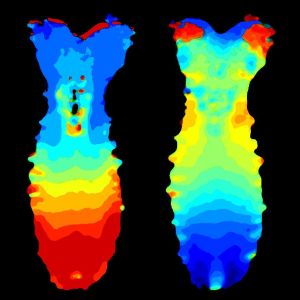
The images shows timing maps of neural activity throughout the entire central nervous system of a Drosophila larva during fictive backward (left) and forward (right) crawling. (Credit: Kristin Branson, William Lemon and Philipp Keller, HHMIJanelia Research Campus.)
Using imaging technology together with technology for detecting neuronal activity from specific groups of cells, a team of researchers has been able to “film” the activity of the entire central nervous system of a developing fly, Drosophila melanogaster.
This type of methodology is expected to help advance the understanding of the neuronal networks that dictate animal behaviour.
Original research paper published in Nature Communications on August 11, 2015.
Names and affiliations of selected author
